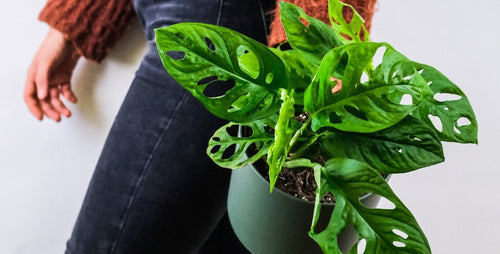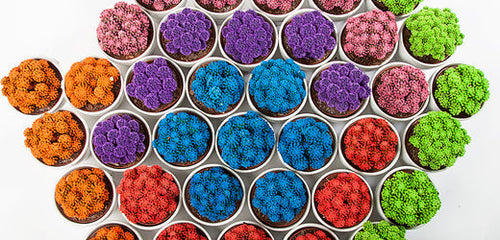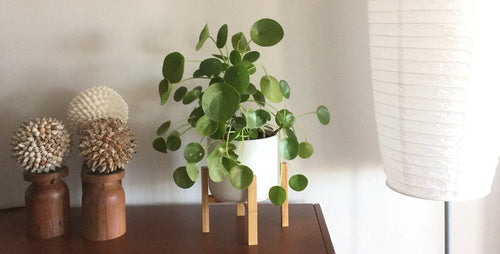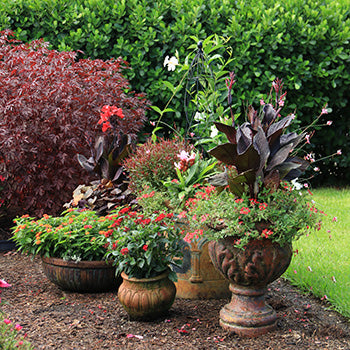
Cacti are plants with diverse personalities! They come in a wide array of shapes -- from round barrels to tall cylinders to bubbly clumps. Some stand up straight and across the ground. There are species that measure just inches high and some that grow several feet tall. Some cacti are green and others offer textural exteriors such as white webbing or long golden spines. And (surprise!) cacti species bloom just like other plants ( only perhaps less often). When it happens, it’s a special treat.
Although most cacti have a prickly exterior, they couldn’t be going. In fact, cacti are one of the most low-maintenance plants around. They require so little attention: Give them , a little water, and just enjoy them.
In this Shopping Guide, we’ll tell you the following:
- Is it “Cactus” or “Cacti?”
- What’s the Difference Between Cacti and Succulents?
- Meet the Family: Types of Cacti
- How to Shop for Cacti
- Caring for Cacti Indoors: Light, Water, Feeding, Repotting
- Caring for Containers with Pebble Mulch
- Choosing Cacti for Outdoors
Is It “Cactus” or “Cacti?”
It’s both, depending on the number of plants you are talking about. “Cacti” is the plural form of the word; if you have two plants, you have cacti. “Cactus” is singular; if you have one plant, you have a cactus.
What’s the Difference Between Cacti and Succulents?
You hear these two plant terms throw together a lot. And they are combined a lot in planting situations too (think cacti and succulent bowls). But here’s the difference between the two. All cacti are succulents. But not all succulents are cacti. All succulents have thick fleshy parts that store water. But cacti are different from succulents in that they always have external spines and they never have . If it’s prickly, it’s probably cacti.
Meet the Family: Types of Cacti
The cacti family is a large one. There are more than 1750 species. Costa Farms sells more than 50 varieties; we’ve selected fun, unusual, and easy-to-grow cacti so that you’ll have the most success indoors and out. Also, there are two kinds of cacti: desert cacti have spines and are from dry regions and forest cacti are from subtropical areas and include Christmas cactus.
When you think of the classic cacti, a saguaro might come to mind (it’s the cacti in most Road Runner cartoons and an iconic part of the American Desert Southwest landscape—and ). BTW, Costa Farms doesn’t sell saguaros. But many cacti grow in a treelike form like a saguaro, which is tall and singular, such as Mexican Fencepost Cactus (Lemaireocereus ) or Candelabra Cactus (Euphorbia compacta).
Other cacti are more rounded, short, and squat, such as Blue Barrel Cactus (Ferocactus ) or Balloon Cactus (Parodia ). These plants are perfect if you don’t have a lot of space or only grow in containers such as low, dishes. Other cacti grow in clusters, such as Fairy Castle Cactus (Acanthocereus tetragonus 'Fairy Castle') or Lemon Ladyfinger Cactus (Mammillaria ‘Lemon’).
How to Shop for Cacti
Here are some general guidelines for shopping for cacti.
1. Look for Dry Soil
You don’t want to buy cacti that have been overwatered. The soil should be dry to the touch.
2. Check for Leaning
If cacti receive too little light, they may lean toward the light. This is a problem that can be corrected by placing your cactus in the right light and rotating the pot occasionally to even it out.
3. Bring a Container for Transport
Bring a box or plastic bin to set cacti in when driving it home. The soil is very dry and may come out of the pot easily if overturned. A box keeps plants upright and from spilling on the way home.

Caring for Cacti Indoors: Light, Feeding, Water, Repotting
Adding cacti to your interior spaces is easy. These easy-care plants match any décor, adding architectural and sculptural appeal. Pot them up in colorful containers that complement the plants' shape, texture, and color. Add them as single specimens in a pot or group them together. Position them on a bright windowsill or tabletop in any room. Follow these rules for care.
1. Set in Bright Light
Cacti need a bright, sunny spot inside your home. A south window is best. But most cacti are somewhere forgiving and can thrive in artificial light, the type of light that you might have in your office.
2. Watch for Blooms
If they get enough light, over time, your cacti may bloom, producing white, pink, red, orange, yellow, or purple flowers, depending on the species.
3. Water Sparingly
Most cacti are natives of dry areas and have adapted to little rainfall. Indoor cactus has that same hardy characteristic. Water plants once every two or three weeks. It's best to water too little; cacti will rot if soil is too moist.
4. Feed Occasionally
Most cacti grow slowly and don't require fertilizer the way faster-growing plants do. But if you want to feed your cactus, use a general-purple houseplant fertilizer in spring and summer. Follow the directions on the packaging and don’t overfeed.
5. Prune or Trim If Needed
Because they're slow growers, you typically don't have to worry about pruning cacti.
6. With Care
Cacti have small root systems so they don’t need repotting very often. Depending on the variety, once every three or four years may be enough. When is it time? When the roots tightly fill the inside of the container or if the plant has grown too large to stay stable in its container. NOTE: When you remove the cactus from the pot, you can do this in a variety of ways: use tongs, gloves, or a folded towel. Take care handling cacti because their spines vary in pokiness and you don’t want to be tweezing spines out of your fingers and hands. Ouch!
7. Give as Gifts
If you are looking for colorful cacti to brighten a windowsill or give as a gift, try Desert Gems.
Caring for Containers with Pebble Mulch
You may buy in a container that has a layer of mulch to cover the potting mix. Pebbles are a stylish mulch option. They add a textural accent to cacti. In many of our , we glue the rocks in place so you can enjoy a more fuss-free plant. Learn more about watering and other care of pebble mulched plants.
Cacti Flowers
If you provide good growing conditions, your cacti may produce flowers. Each species has its own bloom schedule and flower color. It can be magical when your cacti ! For a fun splash of year-round color, some cacti are sold with natural glued on. You can enjoy these dried flowers all year or carefully remove them with tweezers. Note: The glue used does not harm the cacti.

Choosing Cacti for Outdoors
If you live in a temperate area, you can use cacti as landscape plants. Choose a well-drained spot, such as the top of a sunny slope or a rock garden. Don't plant cacti where they'll be wet for extended periods. Follow the same design rules when planting with cacti as you do when using regular plants. For example, add vertical interest with tall cacti. A series of tall cacti (like a hedge) can be an effective barrier planting. Use tall cacti in the back of the border as a backdrop for other plants. Low-growing, mounding cacti add vertical interest to landscapes and can be combined with other cacti and succulents. For example, you can edge a walkway with short cacti.
Cacti are also ideal containers plantings. Place containers of cacti on sunny decks, patios, or balconies. They love hot spots in your yard. Just make sure containers have drainage holes.
If you live in a climate where temperatures drop, you can enjoy pots of cacti outdoors for the summer, then bring them indoors for the winter. Use the sculptural shapes of cacti like you do other plants in containers. Use tall cacti as the horizontal or “thriller” element in a container. Add mounding cactus as the “filler” and trailing cactus as the “spiller.”
Learn More!
See how to plant cacti and succulents in this video.
See our entire cacti selections.

















